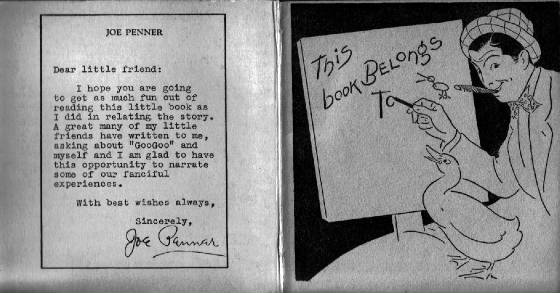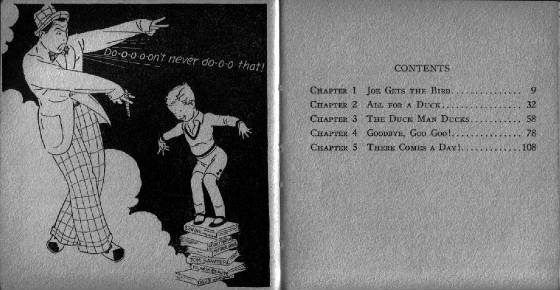|
Beginning in the summer of 1933 (as was befitting his newly-won stature as a bankable multi-platform star), Penner began
to be featured in the national news, general interest, trade and fan publications of the day. In addition to all of this coverage,
at least two special publications -- Joe Penner's Duck Farm
and Joe Penner's Joy Book -- were devoted to radio's ubiquitous
duck salesman.
Joe Penner's Joy Book was published in
mid-1934 by Dell. The magazine style presentation was clearly hurried into production to provide biographical information
to a Penner-hungry public, as difficult as that may be to imagine today. Because Penner's rise to stardom was swift, there
wasn't much information available, and this publication filled the need well. Part biography and part cartoon and gag
collection (with a little sheet music thrown in), it sold very well at 10 cents per copy. --- To
read a scanned 7-page biography of Penner from this publication (it has some photos I haven't seen elsewhere), just click
the Joy Book cover.
Joe Penner's
Duck Farm was published in early 1935 by the Goldsmith Publishing Company of Chicago as part of their Radio Star Series. The other three volumes in the series featured fellow radio comedians Eddie Cantor, Ed Wynn
and Baron Munchausen. Measuring 5"x5", the 126 page perfect bound (it has a spine) softcover
publication was created for Penner's younger fans, and told the story (credited to Harold Sherman) of a fictional character
named "Joe Penner" who found himself broke and hungry in the small town of Tumbling Falls and, through his sense
of humor (and decency), winds up being elected Mayor of the town (which -- until his fortuitous arrival -- was being run by
the sort of crooked politicians who would feel at home in a Frank Capra picture). Along the way, GooGoo the duck and the beautiful
Susabella are introduced, and dozens of Joe's catchphrases find their way into print. The book
also featured 63 pen and ink comic drawings by noted illustrator Henry Vallely. Below are two spreads from the book featuring is a brief note from Joe to his young fans, a bookplate page, the list of
chapters, and two of Valley's drawings (just click to enlarge).


|
|
Penner appeared on the cover of the January 1934 issue of Radio Guide,
the #1 circulation radio publication of the era. His Baker's Broadcast radio program
had been on the air for a scant two months when the magazine hit the stands, a testament to the show's virtually overnight
popularity. Although the issue didn't carry a feature article on Penner, he did appear with
Dizzy Dean of the St. Louis Cardinals in a photo taken at the 1934 World Series (Penner was a huge baseball fan). The Penner
radio program was also represented in this same issue with a nice personality feature on the band leader of The Baker's Broadcast, Ozzie Nelson.
In September of 1934, Photoplay ran the first of many "rags-to-riches"
themed features on Penner's climb to fame and fortune. Titled "Hollywood Buys a Duck," the article discussed
how Tinseltown ended up paying a premium for Penner's services following his radio success, despite the fact that he had
made several two-reel shorts in the early 1930s to little notice from the movie capital. The piece goes on to discuss
how he met his wife (the former Eleanor Mae Vogt was a dancer in one of his early Broadway shows), how he got into radio in
the first place, and how surprised he'd been when he made a hit with his appearance on the Rudy Vallee program. Penner's
humility is in evidence throughout the interview, but especially in the closing quote: "I'm
working hard now and cashing in while I can," he says. "I probably won't last long. You see, I'm not really
great. Maybe the public will tire of me before long, and I'll lose my popularity. But, gee, while it lasts, it's grand!
And I still can't believe it.
---
In their November 10, 1934 issue, the venerable weekly The Saturday
Evening Post jumped on the Penner wagon with a feature titled, "Wanna Buy a Duck?" The article -- attributed
to Penner himself -- discusses the origins of his most famous catchphrase (ad libbed on a Birmingham, Alabama stage in 1931),
and goes on to cover Penner's lack of dramatic ambitions ("Maybe someday they will stuff me and put me in the Smithsonian
Institution labeled A Comedian Who Never Wanted To Play Hamlet."), how he was tricked into auditioning for the radio
by his agent and wife, and why his new success won't go to his head. To quote Penner: "I do exactly the same stuff I've been doing for years in Vaudeville. I play the same theaters in the same
towns...of course, with the radio a million people hear me and know me where a thousand heard me and knew me before. But I
didn't have anything to do with that. It just happened." ---
In September of 1936, Radio Guide ran a feature
article titled, "His Duck's Goose is Cooked," explaining why Penner would not be "selling ducks" or
using duck gags on The Park Avenue Penners, his upcoming CBS situation comedy program
for sponsor Cocomalt. A good portion of the article focused on several episodes in his youth and teen years, where he sold
a variety of items from magazine subscriptions to violin lessons. It concludes with his thoughts on Hollywood (where he had
already appeared in two features) and his new radio program. In closing, the article read, "He's
not particularly worried about the new show; he thinks it's good and there's no particular idea in his mind that he's
making a "comeback."
Rival publication Radio Mirror must have
missed the "no comeback" memo, for that same month (September 1936) it carried a slightly more dramatic article
titled, "The Secret Behind Joe Penner's Comeback." It discussed how -- after his initial success with his catchphrases
and duck jokes -- Penner wanted to try his hand at a situation comedy program like Jack Benny's. Unfortunately, he was
unable to convince his sponsor at the time to let him do that. Instead, he took a year off and traveled to Europe. Upon
his return, he was given the chance to try the new style program for a new sponsor, Cocomalt. Old news now, but topical stuff
then.
|